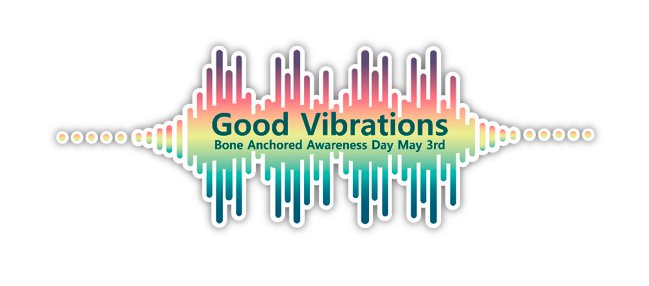Bone Anchored Awareness Day
May 3rd will be the first ever annual Bone Anchored Awareness Day.

Oticon Medical initiates this annually recurring awareness day “Good Vibrations” to celebrate bone anchored hearing as a treatment and to create more awareness about this treatment.
Today over 250,000 people – from all over the globe – use some form of bone conductions hearing device. May 3rd, is meant to celebrate them and the treatment – regardless of brand. Providing a day where the users can talk about their bone anchored hearing device.
“At Oticon Medical we recognize the importance of sound, for wellbeing, for development – even for general health. So of course, we are passionate about providing as many people as possible with the best sound imaginable. That also means creating more awareness – not just for product – but for the treatment itself. We hear much too often,” Oticon Medical CEO, Jes Olsen says, “that a person didn’t know that their hearing loss could be alleviated, and therefore have gone years and years unaided. This day, May 3rd, is our contribution to keeping the conversation of hearing alive” Jes Olsen finishes by wishing all of us a happy and vibrant Good Vibrations day.
At Oticon Medical we recognize the importance of sound, for wellbeing, for development – even for general health
Oticon Medical will be celebrating the date all over the world, with events, information, contests and fun and games. Different activities and events in different countries. It is our hope that other bone anchored brands will join in – making Good Vibrations a true non-brand awareness day. Focussing on the people; on the treatment. The idea is to talk about hearing loss and treatment – not products.
Good Vibrations posts, stories, tweets, reels etc. can be shared by all using the #goodvibrations and the #boneanchoredhearing hashtags and they can be shared on the GoodVibrations Facebook page.
The date, May 3rd is carefully selected as it is the birthday of Per-Ingvar Brånemark. Brånemark was a Swedish physician and research professor and is known as father of osseointegration and the godfather of bone anchored hearing, because his discoveries enabled today’s bone conduction hearing devices.
Therefore, Oticon Medical chose Brånemark’s birthday as annual awareness day for bone anchored hearing. On May 3rd, we want to celebrate the more than 250,000 people all over the world that, today, use bone anchored hearing devices.
Brånemark coined the term osseointegration in the 1960s during studies in bone rheology and defined it as the direct contact between a metal (often titanium) implant and living bone tissue.
The first clinical application of titanium implants was in oral surgery, where they continue to be used today. By chance these first dental implants led the way for the first bone conduction hearing implant. In the beginning Brånemark was looking to evaluate the titanium implant’s ability to be fused with the bone. In the process, he used an acoustic method of measurement where he put a bone vibrator on a patient with a dental implant.
One patient, that by chance suffered from hearing loss, heard a sound when the vibrator started. An unexpectedly loud sound, especially for one suffering from hearing loss. A new discovery was born – a bone-anchored implant could be used to send sound efficiently through bone directly to the inner ear.
That was the beginning of a totally new way of treating people who had, up until this point, not been able to hear as they could not benefit from traditional air conduction hearing aids.
Bone anchored hearing systems today consist of a small implant, an abutment/connector and a sound processor that attaches to the abutment/connector. The sound processor transmits sound by conduction through bone directly into the cochlea. In this way, bone anchored hearing systems use both the body’s natural ability to conduct sound as well as its ability to osseointegrate, and thus securing, an implant.
Def.: Osseointegration (from Latin osseus "bony" and integrare "to make whole") is the direct structural and functional connection between living bone and the surface of a load-bearing artificial implant